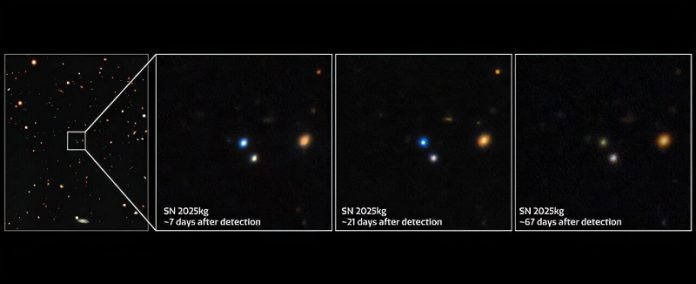
Astronomers have made a major discovery about strange bursts of X-rays in space, known as fast X-ray transients (FXTs).
These mysterious flashes, which only last from seconds to hours, have puzzled scientists for years.
Now, researchers have linked an FXT to the explosive death of a massive star—offering a glimpse into a powerful but previously misunderstood type of stellar explosion.
The breakthrough comes thanks to a rare FXT named EP 250108a, which was detected in January 2025 by the Einstein Probe (EP), a space telescope launched in 2024 specifically to study sudden X-ray events.
At a distance of 2.8 billion light-years, EP 250108a is the closest FXT ever recorded, making it easier for astronomers to study in detail.
Once the signal was detected, an international team of astronomers quickly mobilized to observe the event with several ground-based telescopes.
These included the Gemini South and Gemini North telescopes—part of the International Gemini Observatory—and the SOAR telescope in Chile. They observed EP 250108a across multiple wavelengths, including optical and infrared light, allowing them to gather valuable information about its evolution.
The Gemini telescopes captured a signal consistent with a supernova—the explosive death of a massive star. But what made this event unique was how it behaved in the early days after detection.
The data suggest that EP 250108a was a “failed” version of a gamma-ray burst (GRB), the most powerful type of explosion in the universe.
Gamma-ray bursts happen when a dying star’s core collapses, producing high-speed jets that punch through the star’s outer layers and release intense gamma rays.
But in the case of EP 250108a, the jets didn’t make it all the way out. Instead, they got stuck inside the star, where their energy was released in the form of X-rays—what we saw as the FXT.
Rob Eyles-Ferris, a postdoctoral researcher at the University of Leicester and lead author of one of the two companion studies, said that this event behaves almost like a gamma-ray burst supernova but with an important twist. “Our observations show that massive star explosions can produce either type of event,” he explained.
Further optical observations confirmed that EP 250108a was linked to a Type Ic broad-lined supernova—a specific kind of star explosion without hydrogen or helium in its outer layers. These observations were crucial in understanding the nature of the event, especially as the X-ray signal faded. Infrared data from the SOAR telescope helped estimate the peak brightness of the supernova, allowing researchers to calculate that the original star likely had a mass 15 to 30 times greater than our sun.
Jillian Rastinejad, a Ph.D. student at Northwestern University and lead author of the second companion paper, emphasized that the study proves FXTs can come from the deaths of massive stars. It also shows a clear connection between GRBs and FXTs: both are caused by jets, but GRBs result from successful jets that escape the star, while FXTs happen when the jets are trapped or too weak.
This discovery suggests that FXTs might be much more common than GRBs. Since the Einstein Probe’s launch, several FXTs have been detected each month, compared to just a few GRBs each year. The results highlight the need to rethink what we know about how massive stars die.
Looking ahead, telescopes like the upcoming Vera C. Rubin Observatory will give astronomers even more data on these events. With its Legacy Survey of Space and Time (LSST), the observatory is expected to provide deep insights into the full range of stellar explosions—including FXTs.
This discovery marks a big step forward in understanding the life cycles of stars and the dramatic ways in which they end.
Source: KSR.



